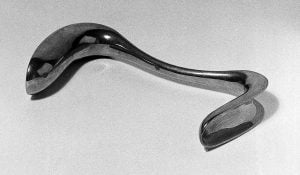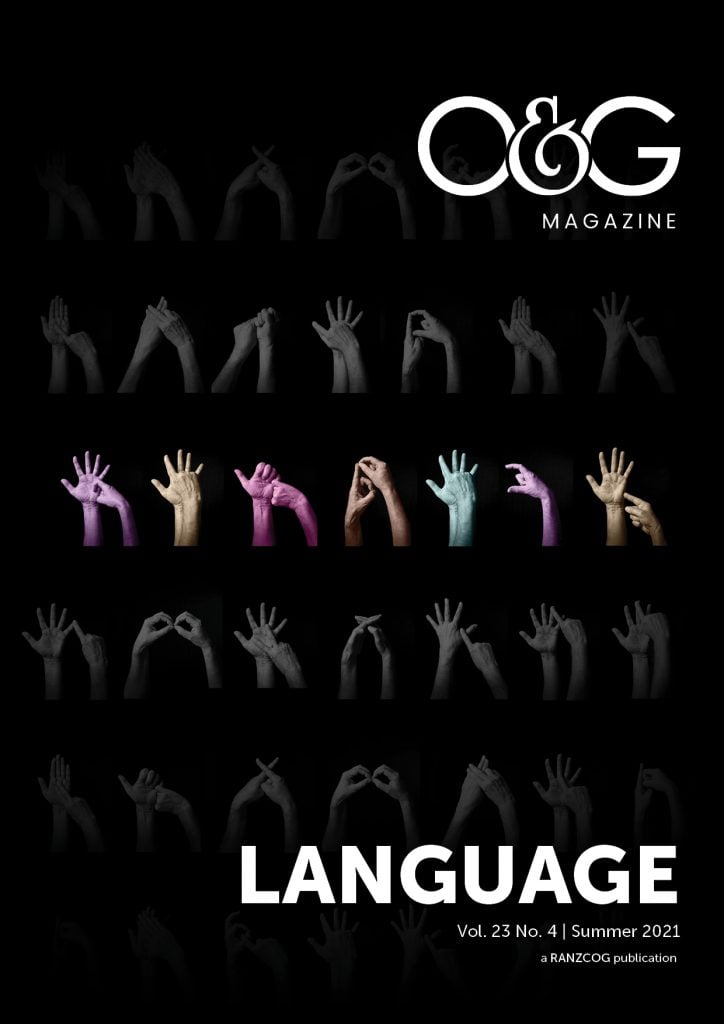In this article, we provide a brief insight into the history of Sims’ speculum, its namesake and why we believe it is time to rename it. We outline the main stakeholders who would be involved in the name-changing process, provide the rationale for renaming it Lucy’s speculum, and outline our strategy to implement this change in the Australian medical community. We aim to not only change the name of Sims’ speculum, but to start a conversation about the history of racism and misogyny in medicine.

Marion Sims duck-bill obstetric speculum. Wellcome Collection. Attribution 4.0 International (CC BY 4.0).
The Sims’ vaginal speculum owes its name to Dr J Marion Sims, the man upon whom the title ‘father of modern gynaecology’ was once bestowed.1 For over a century, he comfortably maintained this title and was described as a heroic figure by doctors and medical textbooks alike. More recently, however, Sims’ behaviour has been re-examined and knowledge of his various malpractices have come to light. Between the years of 1845 and 1849, Sims performed a series of experiments on enslaved African American women in order to perfect the surgical management of vesicovaginal fistula. Until 1849, Sims’ operations all failed2 and were carried out without anaesthesia, which first came into use in 1846.3 Moreover, it remains unclear as to whether the patients consented to these procedures.4 One slave, Anarcha, had 30 experiments performed on her after Sims failed to operate successfully time after time.5 Sims’ experiments caused obvious harm to his patients, including a slave named Lucy. After one unsuccessful procedure, Sims recorded that –
‘Lucy’s agony was extreme. She was much prostrated, and I thought that she was going to die. … After she had recovered entirely from the effects of this unfortunate experiment, I put her on a table, to examine.’6
Although Sims’ actions may have been in keeping with the societal and medical norms of his era, today they can only be viewed as abhorrent.
Interestingly, after perfecting his fistula repair technique, Sims performed the operation on numerous white women, always using anaesthesia during these procedures.7 Additionally, Sims’ intentions for perfecting the fistula repair procedure were at best, murky, and at worst, callous and narcissistic. Sims once stated that he ‘hated…investigating the organs of the female pelvis’ and ‘felt no particular interest in [his] profession at the beginning… apart from making a living’.8 From these statements, it is clear that his obsession with gynaecology arose once he recognised that he could earn a fortune by specialising in the field. Hence, he exploited the power imbalance that existed between African American slaves and white men in the 19th century. By using Sims’ name to refer to the U-shaped speculum and the left lateral position for perineal and per-rectal examinations, we are condoning the unethical, sexist and racist actions of a man who used vulnerable African American women as a means to advance his status and career. More broadly, we are encouraging the exploitation of vulnerable communities in order to achieve personal and professional gain. It is our responsibility to make amends – we have already waited far too long to do so.
We propose that the Australian medical community follows in the footsteps of a growing American movement to acknowledge the brutality of Sims’ actions. The University of Alabama has removed a painting depicting Sims as one of the ‘Medical Giants of Alabama’,9 and the mayoral commission of New York City catalysed the relocation of Sims’ statue from Central Park.10 11 We suggest that the Sims speculum should be renamed after one of the slaves who endured the agony of Sims’ inhumane experiments: Lucy.
This alternative name, Lucy’s speculum, has already been adopted by several doctors, medical institutions and universities around the globe. Dr Kameelah Phillips, an O&G in New York, has spearheaded this international movement, and describes the desire to rename it to Lucy’s speculum ‘in honor of the named and unnamed black bodies that have contributed to our progression of science and medicine.’ Dr Phillips has also thanked ‘the thousands of doctors who have committed to Lucy’s memory by using her name in [their] operating rooms and – in doing so – share her story.’
We are confident that this change can be implemented successfully in Australia, given its rapid uptake in other parts of the world, mirroring the strategies used to implement the name changes associated with conditions such as granulomatosis with polyangiitis12 13 and reactive arthritis14 in recent times.
There are many stakeholders who must be involved in the process of reclaiming the name of Sims’ speculum. Doctors, who use the devices, as well as nurses and other theatre staff would have to start referring to the device as Lucy’s speculum. Time and energy would need to be taken to re-educate all staff about the name change and reasons behind it. As part of this effort, several re-labelling changes would also need to occur. Hospitals would have to relabel the devices, so as not to cause confusion. Furthermore, manufacturers would have to rebrand and re-advertise the U-shaped speculum.
Aside from renaming the physical instrument, amendments would need to be made to educational materials. For example, hospitals and guideline-developing organisations may have to rename the device in management guidelines and protocols. Furthermore, the change of terminology would be particularly important whilst teaching medical and other healthcare students. As such, universities will hold a major stake in this change. From lecture slides to recommended textbooks and other resources, it would take a concerted effort for university lecturers, tutors and administrators to make the necessary changes.
However, patients must also be at the centre of this movement. Patient advocate groups for conditions that commonly require the use of Sims speculum should be consulted throughout the process. These would include patient advocate groups for conditions such as endometriosis and infertility. In particular, the voices of women of colour, who were historically most affected by men like Sims, should be amplified in this campaign. The doctor-patient relationship centres around trust, and this is more relevant than ever during gynaecological procedures. As such, it is essential that the language we use creates an environment in which all people feel comfortable and accepted.
We recognise that changing the name of Sims speculum to Lucy’s speculum, is not a simple task. The breadth of stakeholders invested in the Sims speculum render a one-dimensional campaign ineffective. For this reason, the advocacy campaign we envision is multifaceted and aims to create both systemic and cultural change.
In order to change current practice, we would target systemic factors, primarily labelling used by speculum manufacturers, hospitals, outpatient facilities as well as general practices. A digital package, explaining the name change and providing a template for stickers to change the product’s name, could be provided to all these facilities. This would be a way to simplify and centralise the process. We would also focus on informing future practitioners through educating students and targeting educational facilities. A package could be distributed to universities, with a focus on educational material about the history of Sims and the development of the speculum.
Parallel to this, a dialectical approach would target practitioners and encourage conversations between staff to spread the word about the new name. Informal discussions between colleagues in theatre or tea rooms could be reinforced by physical markers of commitment to the change such as posters advertising the name change for communal staff areas. Furthermore, individuals could wear stickers on their name badges and lanyards. Funding to support this initiative, such as from medical societies, could allow these to be widely distributed. Simultaneously, a virtual campaign would continue the conversation outside of the workplace. We would run a broad social media campaign, primarily on Twitter and Facebook, targeting individual healthcare professionals and using the hashtag #lucyslegacy. We would also engage patient advocacy groups online, and utilise their large forums, to provide a consumer voice to the campaign.
Increasingly, the importance of language in medicine is being recognised. By continuing to award Sims with the name of the speculum, we are condoning the history of violence and abuse and implicitly lauding Sims for his contributions. This campaign represents an opportunity to solidify modern Australian O&Gs’, as well as the whole medical communities’, commitment to patient-centred, non-discriminatory healthcare, leaving Sims and his practices in the 19th century where they belong.
The authors of this article are a group of medical students from around Australia who are all members of the Australian Medical Students Association (AMSA) Sexual and Reproductive Health committee in 2021:
- Anna Shalit (Monash University)
- Andrew Downie (Monash University)
- Mansi Tiwary (University of New South Wales)
- Kirsten Arnold (Monash University)
- Mary Malek (Monash University)
- Afreen Feroze Akbany (University of New South Wales)
- Natasha Walker (University of Newcastle)
- Yahan Xu (University of New South Wales)
- Laura McDuff (University of Notre Dame)
Our feature articles represent the views of our authors and do not necessarily represent the views of the Royal Australian and New Zealand College of Obstetricians and Gynaecologists (RANZCOG), who publish O&G Magazine. While we make every effort to ensure that the information we share is accurate, we welcome any comments, suggestions or correction of errors in our comments section below, or by emailing the editor at [email protected].
References
- Sims JM. The Story of My Life. New York: D. Appleton & Company; 1884.
- Wylie WG. Memorial Sketch of the Life of J. Marion Sims, M.D.. New York: D. Appleton & Company; 1884.
- Robinson DH, Toledo AH. Historical development of modern anesthesia. J Invest Surg. 2012;25(3):141-9.
- Holland B. The ‘Father of Modern Gynecology’ Performed Shocking Experiments on Enslaved Women. HISTORY. 2017 [updated 2018]. Available from: www.history.com/news/the-father-of-modern-gynecology-performed-shocking-experiments-on-slaves.
- Sims JM. The Story of My Life. New York: D. Appleton & Company; 1884.
- Sims JM. The Story of My Life. New York: D. Appleton & Company; 1884.
- Holland B. The ‘Father of Modern Gynecology’ Performed Shocking Experiments on Enslaved Women. HISTORY. 2017 [updated 2018]. Available from: www.history.com/news/the-father-of-modern-gynecology-performed-shocking-experiments-on-slaves.
- Wylie WG. Memorial Sketch of the Life of J. Marion Sims, M.D.. New York: D. Appleton & Company; 1884.
- Zhang S. The Surgeon Who Experimented on Slaves. The Atlantic. 2018. Available from: www.theatlantic.com/health/archive/2018/04/j-marion-sims/558248/.
- Zhang S. The Surgeon Who Experimented on Slaves. The Atlantic. 2018. Available from: www.theatlantic.com/health/archive/2018/04/j-marion-sims/558248/.
- Sayej N. J Marion Sims: controversial statue taken down but debate still rages. The Guardian. 2018. Available from: www.theguardian.com/artanddesign/2018/apr/21/j-marion-sims-statue-removed-new-york-city-black-women.
- Woywodt A, Matteson EL. Wegener’s granulomatosis—probing the untold past of the man behind the eponym. Rheumatology. 2006;45(10):1303-6.
- Falk RJ, Gross WL, Guillevin L, et al. Granulomatosis with Polyangiitis (Wegener’s): An alternative name for Wegener’s Granulomatosis. Arthritis Rheumatol. 2011;63(4):863-4.
- Wallace DJ, Weisman M. Should a war criminal be rewarded with eponymous distinction?: The double life of Hans Reiter (1881-1969). J Clin Rheumatol. 2000;6(1):49-54.





Leave a Reply